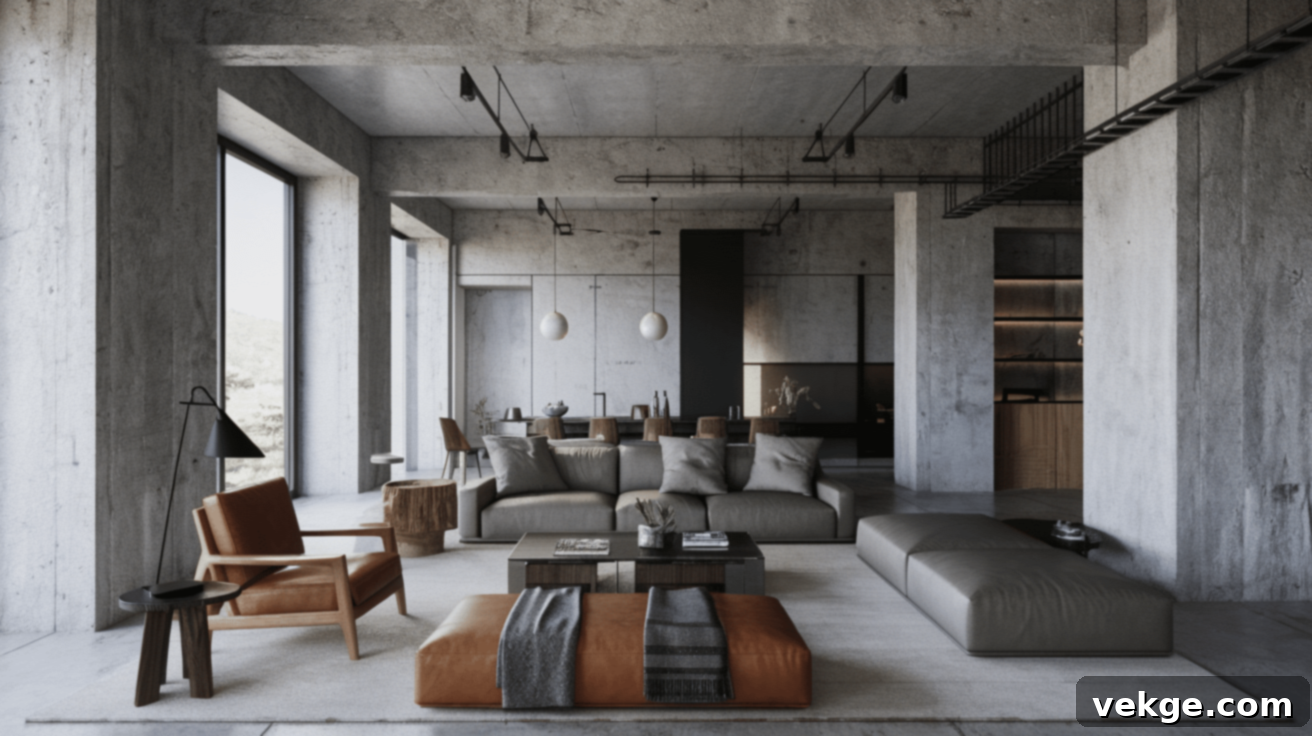Mastering Brutalist Living Room Layouts: A Guide to Raw Elegance and Modern Design
Brutalist design, a captivating style born from the mid-20th century, brings an unvarnished honesty and compelling strength into your home. It’s a design philosophy that champions raw, exposed materials, celebrating their intrinsic beauty without embellishment. Imagine concrete walls that tell a story of their formation, metal accents that gleam with industrial charm, and wood that retains its natural grain and texture. This style isn’t just about aesthetics; it’s about a straightforward, unpretentious approach to living spaces.
At its core, brutalism creates living rooms that are both powerful and inherently simple. The essence lies not only in the materials themselves but equally in the thoughtful arrangement and flow of the space. A well-executed layout can transform a collection of raw elements into a harmonious, striking, yet remarkably livable environment, ensuring it feels bold and inviting rather than cold and stark. It’s about balance—between the hard and the soft, the stark and the warm, the form and the function.
In this comprehensive guide, we will delve into various impactful ways to conceptualize and set up your brutalist living room. You’ll learn the art of balancing robust, unadorned surfaces with essential comfort, crafting a space that is not only visually arresting but also deeply practical and personal. From expansive open-concept designs to intimate, cozy nooks, we’ll explore how to harness the power of brutalist principles to create a truly unique and enduring home environment.
Key Characteristics of Brutalist Living Room Layouts
Brutalist living rooms are built upon foundational design principles, utilizing basic architectural components to forge spaces that are both robust and elegantly simple. This distinct style harmoniously blends rugged textures with precise, clean geometric forms, creating interiors that make a statement.
Embracing Raw Materials
A hallmark of brutalist design is its unapologetic celebration of inherent material qualities. Rather than concealing structural elements, it brings them to the forefront, allowing them to speak for themselves. This means:
- Concrete: Often seen in walls, floors, and even custom-built furniture, concrete offers a solid, cool, and often imposing presence. Its raw, unfinished texture provides a unique visual and tactile experience, embodying the very essence of brutalism.
- Metal: From industrial-grade steel fixtures to exposed conduits and minimalist furniture frames, metal introduces sleek, functional lines and a resilient character. It adds a modern, sometimes utilitarian touch that complements the weight of concrete.
- Brick: When left exposed, brick surfaces bring a touch of natural texture and an unexpected warmth. Its varied tones and historical resonance can soften the more severe aspects of concrete and metal, adding depth and visual interest.
- Wood: Natural, unadorned wood elements, whether in structural beams, large furniture pieces, or flooring, introduce organic patterns and a vital warmth. It acts as a crucial counterpoint, preventing the space from feeling overly stark and grounding the design with an earthy touch.
These materials are typically presented in their natural, unaltered state, free from excessive paint or decorative coverings. This commitment to authenticity creates an honest, straightforward aesthetic, allowing the inherent beauty and structural integrity of the building components to shine through.
The Minimalist Approach to Space
In brutalist spaces, the philosophy of “less is more” is paramount. A deliberate absence of clutter allows the strong forms and textures of the chosen materials to truly resonate. This minimalist approach is characterized by:
- Open Floor Plans: Often featuring expansive, uninterrupted spaces with minimal internal walls, these layouts promote a sense of freedom and airiness.
- Simple Furniture Arrangements: Furniture is strategically placed, focusing on functionality and form, with ample negative space around each piece to highlight its sculptural quality.
- Clean, Straight Lines: Geometric precision is key, with sharp angles and clear definitions that contribute to a sense of order and modern elegance.
- Essentialism: Only items that are genuinely needed or serve a clear purpose are included, reducing visual noise and emphasizing the core elements of the design.
This deliberate simplicity in layout helps to direct attention toward the commanding shapes and tactile qualities of the brutalist materials. Crucially, empty space is considered as vital and impactful as the objects within it, contributing to the overall sense of calm and clarity.
Sculptural Furniture as Art
Furniture in a brutalist living room transcends mere utility; it functions as a curated collection of art pieces. Each item is chosen for its commanding presence and distinctive form, contributing to the overall architectural narrative of the room:
- Bold Sofas: Look for large, substantial sofas with strong, defined shapes, often in neutral tones or textured fabrics that complement the raw materials. These pieces anchor the room and invite comfort.
- Chunky Coffee Tables: Often made from concrete, stone, or thick wood, these tables feature interesting, robust bases that make them central focal points.
- Statement Chairs: Chairs are selected for their artistic silhouettes, sometimes resembling abstract sculptures, offering both seating and visual intrigue.
- Dramatic Lighting: Lamps are chosen not just for their illumination but for their ability to cast interesting shadows and highlight textures, acting as sculptural elements in themselves.
Every piece is designed to stand out, making a powerful statement about the seamless integration of form and function. Brutalist design feels inherently honest because it reveals the true nature of construction and material, making it an ideal choice for those who appreciate strong, clear aesthetic decisions without unnecessary ornamentation.
Innovative Brutalist Living Room Layout Ideas
Brutalist living rooms can adopt a multitude of forms, each offering a distinct atmosphere while remaining true to the style’s core tenets. These carefully conceived spaces masterfully blend expansive layouts with raw, authentic materials, resulting in areas that are both strikingly beautiful and highly functional. A well-planned layout is essential to highlight the best aspects of brutalist design, ensuring the space remains inviting and practical for everyday living.
1. Open-Concept Living Room with Exposed Concrete Walls

An open-concept living room featuring exposed concrete walls makes an immediate and powerful statement, exuding an honest, minimalist, and clean aesthetic. The unadorned concrete serves as a testament to the building’s structural integrity, providing a robust, neutral canvas that allows carefully chosen furnishings to truly stand out. This layout fosters a sense of spaciousness and architectural purity.
To succeed in an open layout, it’s crucial to define distinct zones without resorting to physical walls. Large area rugs are perfect for delineating seating areas or conversation nooks, maintaining an open flow while establishing functional boundaries. The cool, austere nature of concrete can be beautifully balanced with strategically placed warm lighting—think amber-toned bulbs or diffused light sources—to create a more inviting and comfortable ambiance, especially after sunset. Consider indirect lighting that washes the concrete walls to highlight their texture.
Furniture choices should echo the brutalist aesthetic with their low profile and strong forms:
- Sofas: Opt for low-slung designs with clean, straight lines, often in durable, textured fabrics like linen, wool, or even leather that complement the raw environment.
- Coffee Tables: Simple yet substantial coffee tables, crafted from concrete, stone, or thick, solid wood, become sculptural elements within the space.
- Chairs: Select chairs that are aesthetically pleasing from every angle, perhaps with metal frames, sculpted wood, or upholstered in natural tones, contributing to the room’s artful feel.
Industrial-style lighting fixtures, often featuring blackened metal or exposed bulbs, perfectly complement the raw aesthetic. These fixtures not only provide ample illumination but also cast intriguing shadows that emphasize the texture of the concrete walls, adding a layer of drama and sophistication without appearing forced.
2. Industrial Loft-Style Living Room
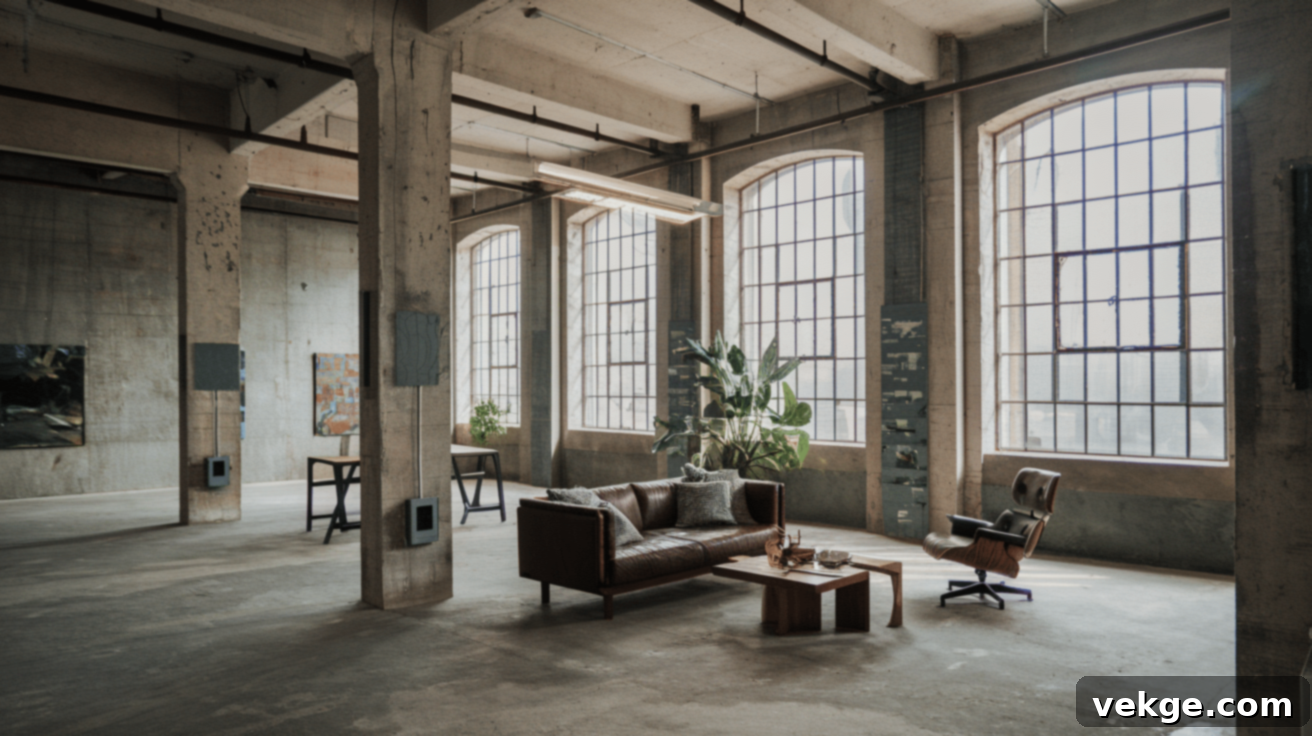
Loft spaces are a natural home for brutalist design, seamlessly integrating its principles with an existing industrial framework. These living rooms often boast inherent industrial characteristics such as soaring ceilings, expansive factory-style windows, and visible structural or mechanical elements, providing an ideal backdrop for brutalist aesthetics.
The beauty of loft layouts lies in their transparency – revealing what is typically concealed. Exposed support beams, ventilation pipes, and electrical conduits transform from mere utilities into integral design features, adding character and a sense of authenticity. Concrete floors or walls provide a robust, neutral foundation that gracefully ages, acquiring a unique patina over time that enhances the space’s narrative.
Natural light plays a transformative role in these environments. Large, factory-style windows, often framed in dark metal, flood the space with abundant light throughout the day, constantly redefining textures and forms. The shifting patterns of sunlight and shadow dramatically highlight the raw materials, bringing dynamism and life to the room. During the evening, thoughtful artificial lighting, perhaps industrial pendants or track lighting, can maintain this dramatic interplay.
Furniture in an industrial brutalist loft must possess significant presence to hold its own within such a bold setting:
- Angular Pieces: Seek out furniture with strong, clean profiles and geometric precision that echo the architectural lines of the loft.
- Material Combinations: Pieces that thoughtfully combine metal and wood, or even concrete, often work best, showcasing the brutalist preference for material honesty.
- Characterful Items: Select furniture that appears to have a history or an interesting story, such as vintage industrial finds or custom-made pieces with a rustic yet refined appeal.
3. Symmetrical Brutalist Living Room
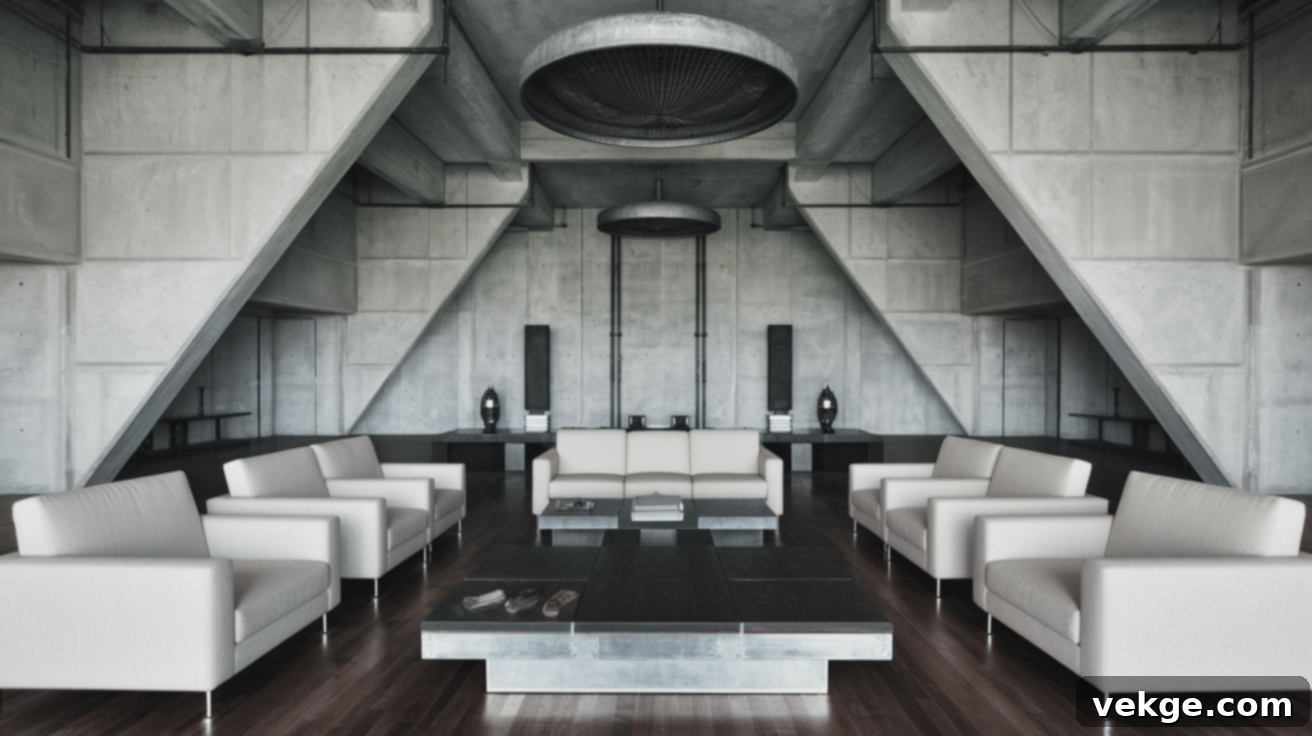
In brutalist design, balance and order can profoundly contribute to a sense of calm and intentionality. A symmetrical layout introduces a structured elegance to even the most formidable materials, making their rough textures feel purposefully integrated rather than haphazard. The fundamental step in creating symmetry is identifying a clear central point within the room from which all other elements radiate.
Once this focal point is established, the arrangement of matching or mirrored elements on either side creates a harmonious equilibrium. Geometric shapes are particularly effective in these spaces, reinforcing the sense of order and precision characteristic of brutalism. Consider architectural features like a fireplace, a prominent window, or a large, central coffee table as your anchor.
Key elements to consider for achieving a striking symmetrical brutalist layout include:
- Strong Focal Point: A fireplace made of concrete, a substantial coffee table, or even a panoramic window view can serve as the central axis around which the room is organized.
- Matching Furniture: Position identical or highly complementary furniture pieces—such as two identical armchairs, console tables, or floor lamps—on either side of your focal point.
- Geometric Repetition: Incorporate geometric patterns through rugs, art, or even the forms of your furniture and accessories to reinforce the structured aesthetic.
- Balanced Lighting: Ensure that lighting fixtures are symmetrically placed to emphasize the balanced arrangement and evenly illuminate both sides of the room, enhancing the sense of order.
A symmetrical layout proves effective in both expansive and more modest rooms. The inherent structure it provides helps to organize and contextualize brutalist materials that might otherwise feel overwhelming, creating a sophisticated and serene environment.
4. Split-Level Living Room with Brutalist Features

Incorporating variations in floor height adds a dynamic layer of interest and architectural complexity to brutalist design. These natural shifts in elevation create clear, yet open, divisions between different functional zones within a single space, maintaining a continuous flow while segmenting areas for distinct purposes.
Split-level rooms excel at offering separation without the need for restrictive walls. For instance, an upper level might be perfectly suited for a quiet reading nook, a compact home office, or a display area for art, while the lower, more expansive area becomes the primary zone for social gatherings, relaxation, and conversation. The transition between these levels, typically via steps, is not merely functional but becomes an intrinsic architectural feature, often crafted from the same raw materials as the rest of the room.
Each level should be considered a distinct space with its own purpose and a thoughtfully designed lighting scheme. This strategic illumination helps to clearly define the areas and enhance their individual ambiance without physically closing them off. The differences in height also open up unique opportunities for interesting sightlines and perspectives across the entire living space, adding visual depth and engagement.
Consider these design ideas to maximize the impact of a split-level brutalist living room:
- Material Steps: Design steps between levels using concrete, exposed brick, or metal, reinforcing the brutalist aesthetic and making the transition a focal point.
- Built-in Seating: Integrate low-profile, built-in seating on the lower level, perhaps crafted from concrete or wood, to create a sense of permanence and architectural integration.
- Minimalist Railings: Opt for simple, understated railings in metal or glass to ensure safety without obstructing views or detracting from the open feel.
- Strategic Lighting: Utilize lighting that specifically highlights the change in height, such as recessed step lighting, dramatic uplights, or pendant lights that draw attention to the vertical dimension.
5. Compact Brutalist Living Room for Small Spaces
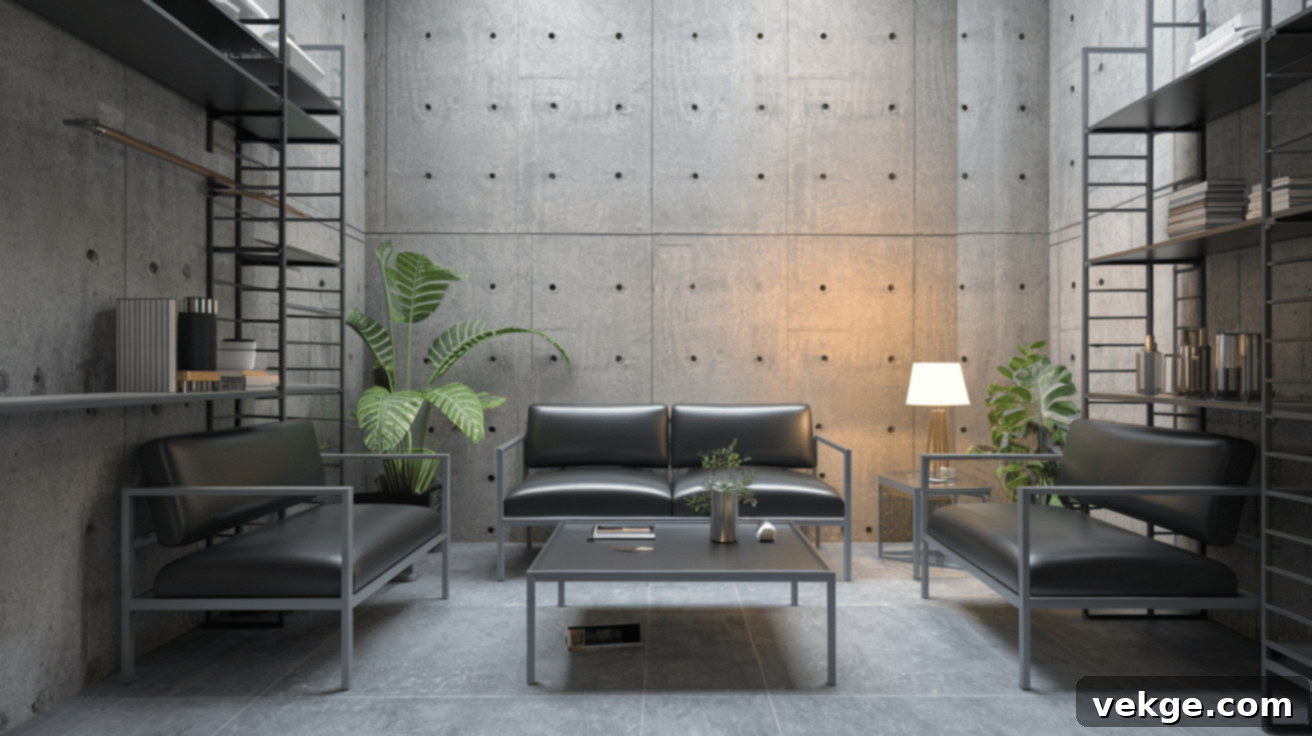
Even small rooms can powerfully embrace the brutalist aesthetic. The key to success in a compact brutalist living room is a disciplined approach: utilizing fewer elements but ensuring each one makes a significant impact. This strategy prevents the space from feeling cluttered while still conveying the style’s inherent strength.
In tighter spaces, it’s best to concentrate on one standout brutalist feature as the focal point. This could be a dramatic concrete accent wall, a distinctive metal light fixture, or a single, striking piece of sculptural furniture. All other elements should remain simple and understated to prevent overwhelming the limited area, allowing the chosen focal point to command attention.
Essential considerations for designing small brutalist spaces include:
- Singular Focal Point: Choose one dominant brutalist feature to draw the eye, making it the hero of the room.
- Multifunctional Furniture: Incorporate pieces that serve multiple purposes, such as sofas with integrated storage, nesting coffee tables, or ottomans that double as extra seating.
- Strategic Color Palette: While brutalism often leans into grays, consider using lighter tones on some surfaces to reflect light and make the room feel larger, balancing darker or heavier elements.
- Wall-Mounted Fixtures: Utilize wall-mounted shelving, lighting, or even desks to free up valuable floor space and maintain clean, uninterrupted lines.
- Maximize Open Floor Space: Keep as much of the floor visible as possible to enhance the perception of openness and flow, adhering to the minimalist principle.
- Directional Lighting: Employ focused, directional lighting to highlight textures, create interesting shadows, and add depth, subtly expanding the visual boundaries of the room.
6. Brutalism with Natural Elements
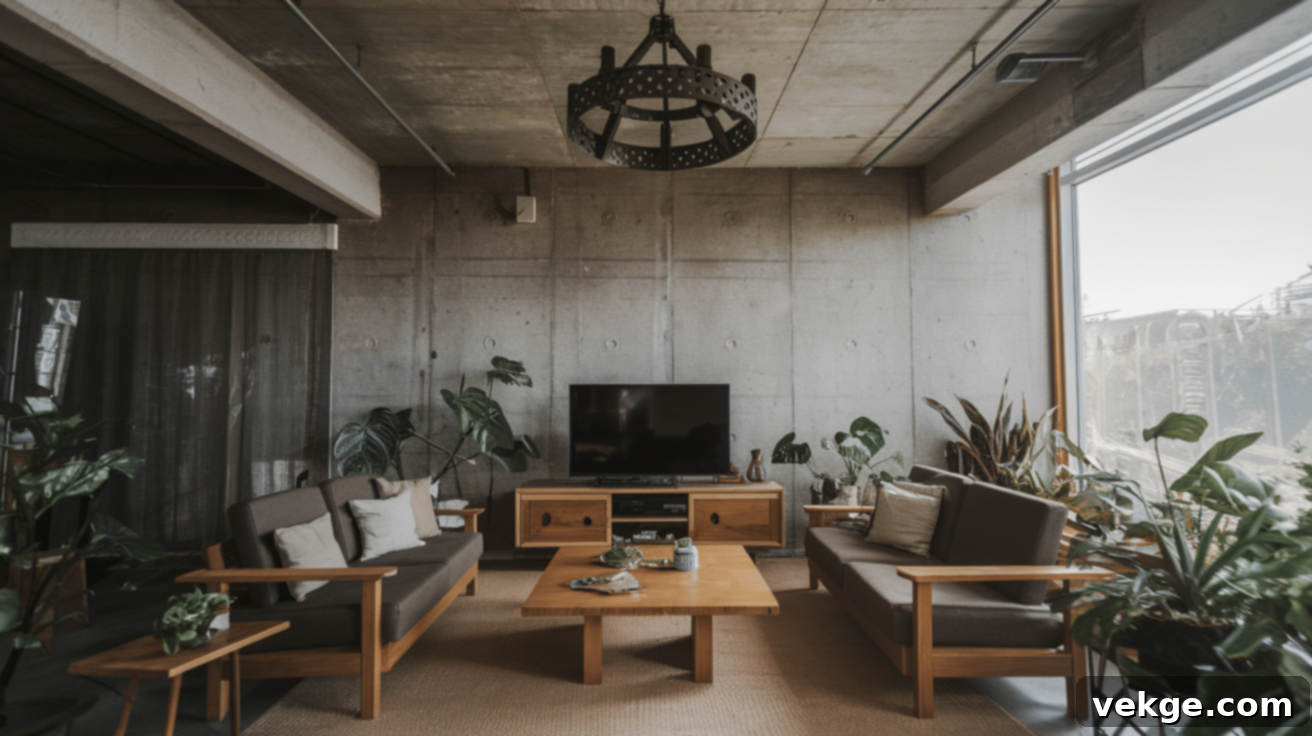
Integrating natural elements into brutalist spaces can profoundly transform their ambiance, infusing a sense of warmth and welcome without compromising the style’s inherent strength. This harmonious combination maintains the raw power of brutalism while rendering it more livable and inviting, creating a balanced and sophisticated interior.
There are several effective ways to incorporate natural elements, softening the industrial edge:
- Wood Accents: Introduce chunky wooden tables, simple, unvarnished benches, or exposed wooden ceiling beams. The natural grain and warm tones of wood provide a beautiful contrast to the cool austerity of concrete and metal, adding organic lines that break brutalist geometry.
- Statement Plants: Select plants with strong, architectural forms, such as snake plants, fiddle-leaf figs, or large cacti. These natural sculptures complement the clean lines and bold shapes of brutalist architecture without adding visual clutter. A few large specimens are often more impactful than many small ones.
- Abundant Natural Light: Maximize natural light through large windows or skylights. The changing quality of natural light throughout the day brings brutalist materials to life, adding dynamic depth and highlighting their textures in ever-evolving ways, even in the simplest brutalist room.
- Organic Materials: Consider incorporating other organic materials like natural fibers in rugs (jute, sisal), wool throws, or stone accessories. These textures provide a tactile contrast that invites touch and interaction, enhancing comfort.
- Water Features: For larger spaces, a simple indoor water feature can introduce a calming, organic sound and visual element that harmonizes with raw materials.
The interplay of wood and plants with concrete and metal not only adds visual interest but also creates a more comfortable and balanced environment. This thoughtful integration demonstrates that brutalist design can indeed be warm, earthy, and deeply connected to nature.
7. Monochrome and Minimalist Layout
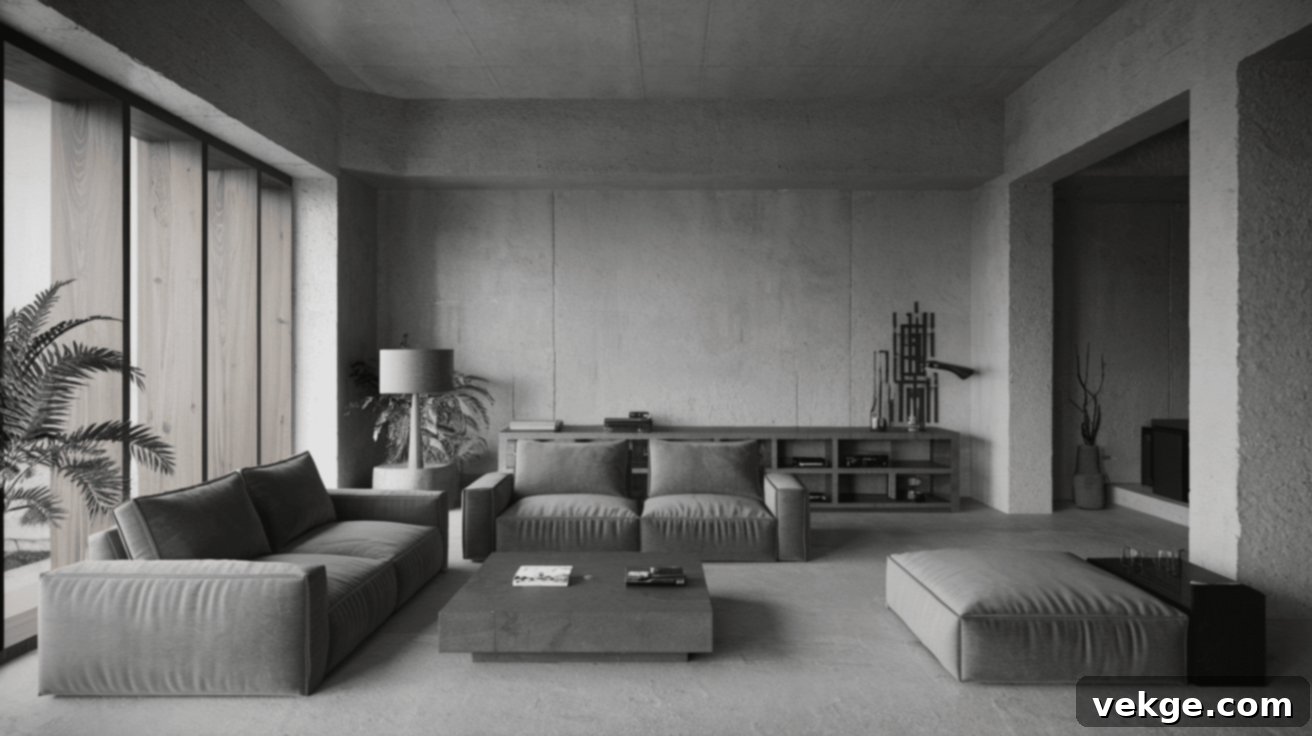
A monochrome color scheme is an exceptionally powerful tool for enhancing the dramatic impact of brutalist spaces. By unifying walls, floors, and furniture within a similar tonal range, you create a cohesive and immersive environment that places the emphasis squarely on architectural forms and textures rather than on disparate colors. This approach results in a highly sophisticated and serene aesthetic.
Gray, with its inherent neutrality and versatility, is a prevalent choice for monochrome brutalist rooms. The magic lies in exploring different shades and textures of gray – from deep charcoal concrete to light ash upholstery, polished metallic accents, and matte stone surfaces. These subtle variations create a rich visual tapestry that maintains a clean, focused, and incredibly chic feel, allowing the intricate details of material surfaces to become the true stars of the room.
In a monochrome layout, furniture arrangement must prioritize clean lines, generous breathing room, and intentional negative space. Each piece needs ample clear space around it to be fully appreciated, akin to sculptures in a gallery. The strategic voids and gaps between items are just as crucial as the items themselves, contributing to the overall sense of calm and visual clarity.
Optimal furniture choices for this refined layout typically include:
- Block-Shaped Sofas: Upholstered in neutral, textured fabrics (like linen, wool, or even a soft concrete-toned leather) that blend seamlessly into the monochrome palette.
- Stone or Concrete Tables: Coffee tables and side tables with simple, geometric forms that highlight the natural beauty and texture of these robust materials.
- Metal Chairs: Chairs with strong, minimalist silhouettes, often in blackened steel, brushed aluminum, or aged bronze, providing sharp contrast and industrial edge.
- Integrated Storage: Storage solutions that blend into walls or architectural features, maintaining the minimalist aesthetic and avoiding visual clutter.
8. Brutalist Living Room with Open Shelving and Industrial Accents

In brutalist spaces, open shelving transcends mere storage, becoming an integral design feature that embodies the style’s honest and functional spirit. Shelves crafted from metal, concrete, or raw wood, often with visible, sturdy brackets, perfectly align with the brutalist ethos of exposed construction and utilitarian beauty. These elements provide both practical storage and opportunities for curated display.
Design your living room so that open shelving systems feel like an extension of the architecture itself. Floor-to-ceiling units, perhaps built into a concrete wall or spanning an entire section, create a powerful visual impact and enhance the room’s structural integrity. The items displayed on these shelves should be carefully chosen for their simplicity and utility, avoiding any clutter that would detract from the clean, unpretentious brutalist aesthetic. Think carefully curated books, a few art objects, or minimalist ceramics.
Industrial touches, such as deliberately exposed pipes, ductwork, and electrical conduits, further enrich the character of brutalist rooms. Instead of attempting to conceal these functional elements, brutalism embraces them, making them visible components of the design. Their linear quality and raw materiality add significant visual interest, creating a sense of authenticity and adhering strictly to brutalist principles.
Statement lighting is particularly effective in these environments, acting as both a light source and an industrial art piece. Look for fixtures with:
- Raw Materials: Such as blackened steel, rusted iron, or unpolished brass, reflecting the honesty of the brutalist palette.
- Simple, Clear Forms: Designs that clearly communicate their purpose, often with exposed mechanisms or bulbs.
- Exposed Bulbs: Edison bulbs or clear-glass bulbs that showcase their filaments, adding a vintage industrial charm.
- Dramatic Shadow Casting: Fixtures designed to create interesting light and shadow patterns, highlighting the textures of walls and surfaces.
9. Cozy Brutalist Living Room with Warmth and Texture
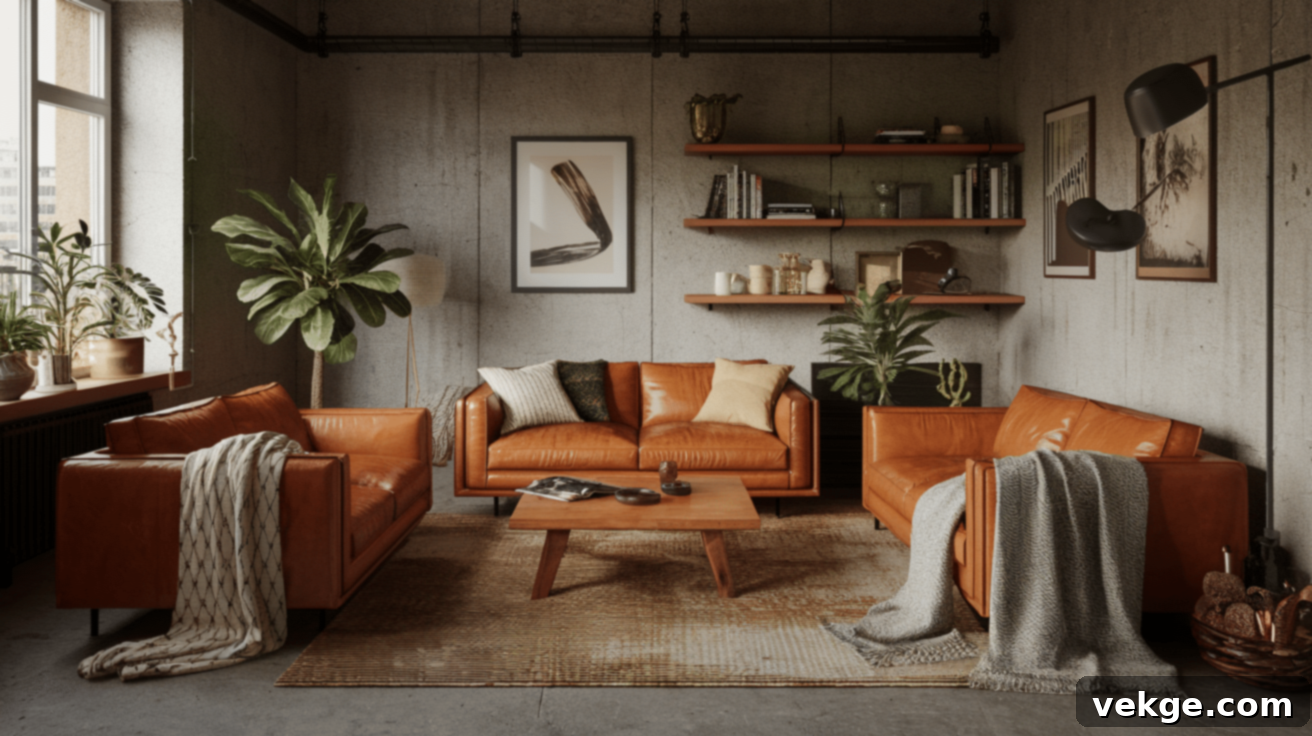
Contrary to popular belief, brutalist spaces do not inherently have to feel cold or austere. By thoughtfully introducing soft elements and varied textures, it’s entirely possible to create an inviting and deeply comfortable room that still celebrates its strong brutalist bones. This approach focuses on contrasting materials to achieve a harmonious balance.
There are numerous effective ways to infuse warmth and tactile comfort into a brutalist living room:
- Layered Rugs: On cool concrete floors, layer plush, textured rugs—think wool, jute, or deep pile—to provide warmth underfoot, enhance acoustics, and define seating areas with softness.
- Throw Pillows and Blankets: Introduce throws and cushions in rich, interesting textures (e.g., chunky knits, faux fur, velvet, or natural linen), focusing on solid colors or subtle patterns that complement, rather than distract from, the brutalist aesthetic.
- Leather Furniture: Invest in high-quality leather sofas or armchairs. Leather ages beautifully, developing a unique patina over time that adds character, warmth, and a lived-in quality, providing a sophisticated counterpoint to concrete and metal.
- Warm-Toned Lighting: Opt for lighting with a warm color temperature (2700K-3000K) instead of harsh cool-white lights. This creates a softer, more intimate glow.
- Varying Light Heights: Employ a mix of floor lamps, table lamps, and wall sconces at different heights to create pools of inviting light, adding depth and coziness.
- Tactile Materials: Incorporate elements like sheepskin throws, boucle fabrics, or rough-hewn wooden accessories that invite touch and interaction, making the space feel more approachable.
Textiles, in particular, play a crucial role in transforming the comfort level of a brutalist room. The choice of materials like soft wool, organic cotton, or rich leather, alongside carefully selected lighting, can bridge the gap between stark brutalist forms and the desire for a truly livable, welcoming sanctuary. This blend creates a space that is both visually powerful and emotionally comforting.
Common Mistakes to Avoid in Brutalist Living Room Layouts
Even the most meticulously planned brutalist living room can inadvertently miss the mark. Understanding common pitfalls and knowing how to circumvent them is vital for crafting a space that not only honors the brutalist aesthetic but also remains exceptionally comfortable and fully functional for everyday life.
1. Too Many Statement Pieces
Mistake: Overcrowding your brutalist living room with too many dominant, attention-grabbing pieces. When every item fiercely competes for attention, the overall effect is counterproductive; nothing truly stands out. The room can quickly transform from a clean, purposeful brutalist haven into a busy, chaotic, and visually confusing space, losing its defining sense of calm and intentionality.
How to fix:
- Prioritize Focus: Select one or, at most, two primary furniture items or architectural features to serve as the undeniable focal points of the room. This could be a dramatic concrete fireplace, a sculptural sofa, or a unique art piece.
- Support with Simplicity: Ensure that all other furnishings and decorative elements are simpler and more subtle in their design. Their role is to complement and support the main statement pieces, not to compete with them.
- Embrace Negative Space: Consciously leave ample empty space around your chosen statement pieces. This breathing room allows each item to be fully appreciated and prevents the room from feeling cramped or over-designed.
- Material as Statement: Remember that in brutalist design, the raw materials themselves—exposed concrete, industrial metal, natural wood—are inherently powerful statements. Often, they require minimal additional embellishment to make an impact.
2. Poor Balance Between Raw Materials and Comfort
Mistake: Designing a brutalist space that looks incredibly striking and impressive in photographs but feels cold, unwelcoming, and uncomfortable in person. A brutalist living room should be a place where people actually want to relax, not just admire from a distance.
How to fix:
- Comfortable Seating: Prioritize seating options that offer genuine comfort and ergonomic support. While forms should be bold, materials should be inviting—think deep cushions, resilient foam, and soft yet durable upholstery.
- Strategic Textiles: Integrate a variety of textiles such as plush area rugs (especially on hard floors), soft throw cushions, and inviting blankets. These elements introduce warmth, absorb sound, and provide crucial tactile comfort.
- Warm Material Mix: Deliberately mix in warmer materials. Natural wood elements, cork, or even certain types of stone can offset the cooler tones of concrete and metal, adding an organic, inviting feel.
- Acoustic Considerations: Hard surfaces (concrete, glass, metal) can lead to excessive echoing. Introduce soft furnishings, wall hangings, and dense rugs to improve acoustics, making conversations more comfortable and the room less reverberant.
3. Lack of Cohesion
Mistake: Assembling a collection of industrial-style or minimalist items without a guiding vision for how they will interact. This results in a disjointed space where elements feel randomly placed rather than part of a unified, thoughtful design. The raw honesty of brutalism should translate to a deliberate, not haphazard, aesthetic.
How to fix:
- Limited Color Palette: Stick to a narrow and consistent color range (e.g., various shades of gray, black, white, and a single accent color from natural wood or a plant). This creates visual harmony and allows textures to shine.
- Repeat Shapes and Forms: Intentionally repeat similar geometric shapes or architectural forms throughout the space, from furniture outlines to the details of accessories. This creates a subtle rhythm and visual connection between elements.
- Consistent Finishes: If using metal, try to use the same type of finish (e.g., brushed steel, matte black, aged brass) across different pieces to create continuity. The same applies to wood tones or concrete textures.
- Integrated Lighting: Ensure your lighting choices complement and enhance the materials you’ve selected, rather than clashing with them. Lighting should reinforce the room’s cohesive mood and highlight its features.
4. Forgetting About Lighting
Mistake: Becoming overly focused on selecting core materials and furniture to the extent that the crucial role of lighting is overlooked or treated as an afterthought. Poor lighting can completely undermine even the most beautifully designed brutalist space, making it feel flat, uninviting, or stark.
How to fix:
- Layered Lighting: Implement a mix of ambient (general), task (functional), and accent (decorative) lighting sources at various heights. This creates depth, allows for mood control, and ensures all areas are adequately lit.
- Highlight Textures: Use directional or grazing lighting (lights placed close to a surface to highlight its texture) to emphasize the unique qualities of concrete, brick, or wood walls. This adds drama and visual interest.
- Consider Natural Light: Analyze how natural light enters and changes throughout the day. Position furniture and use window treatments (or lack thereof) to maximize desirable natural illumination and minimize harsh glares.
- Adjustable Options: Incorporate dimmers for all artificial light sources and choose fixtures with adjustable heads where appropriate. This provides flexibility to change the room’s mood and adapt to different activities.
5. Making It Too Perfect
Mistake: Striving for an overly polished, pristine, or factory-perfect brutalist space. This can inadvertently strip away the very essence of brutalism—its honest, raw, and often imperfect character. The beauty of this style lies in its authenticity and the story materials tell through their natural state.
How to fix:
- Embrace Natural Variations: Choose materials that naturally exhibit variations and imperfections. These “flaws” are what give brutalist spaces their unique soul and depth.
- Celebrate Concrete Patterns: Allow concrete surfaces to display their inherent trowel marks, aggregate exposure, or slight color variations. These are not defects but signs of its natural formation.
- Wood with Character: Select wood with visible grain, knots, and natural imperfections. These elements convey age, authenticity, and a connection to nature.
- Allow Patina to Develop: If using metals like raw steel or brass, embrace the natural patina that develops over time. This aging process adds character, depth, and a sense of history to the material.
By avoiding these common mistakes, you can ensure your brutalist living room is a powerful, authentic, and truly livable space that reflects the thoughtful principles of the style.
Conclusion
The subtle imperfections and inherent variations found within brutalist spaces are not flaws to be hidden, but rather celebrated aspects that contribute immensely to their character and profound depth. They narrate a compelling story of how materials are crafted, how they respond to their environment, and how they gracefully evolve over time, grounding the design in authenticity.
Throughout this guide, we’ve explored nine distinct and inspiring approaches to designing a brutalist living room, ranging from expansive, light-filled open-concept layouts featuring exposed concrete to more intimate, cozy arrangements infused with warmth and rich textures. Each detailed option demonstrates the incredible versatility of robust, unadorned materials, proving that they can create rooms that are simultaneously bold in their aesthetic and remarkably comfortable for everyday living.
As you embark on your brutalist design journey, we encourage you to select a layout that genuinely complements your actual living space and personal lifestyle. A compact brutalist style, for instance, might be the perfect solution for a smaller apartment, maximizing impact in a limited footprint. Conversely, an industrial loft-inspired approach might be ideally suited for spaces with high ceilings and architectural heritage, embracing their inherent grandeur.
Consider the primary functions of your living room—is it predominantly for tranquil relaxation, vibrant entertaining, or perhaps a dedicated zone for working from home? Don’t hesitate to thoughtfully mix and match elements and ideas from different layouts to meticulously craft a space that feels uniquely tailored to your needs and aesthetic preferences. A great starting point is to identify one key brutalist feature that resonates with you and build your design around it, allowing it to inform subsequent choices.
We’d love to hear your thoughts! Which brutalist living room layout resonates most with your design vision? Share your favorite in the comments below!
